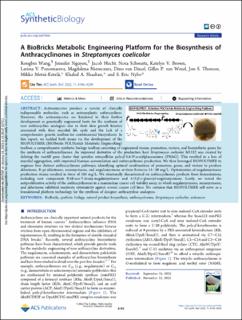| dc.contributor.author | Wang, Rongbin | |
| dc.contributor.author | Nguyen, Jennifer | |
| dc.contributor.author | Hecht, Jacob | |
| dc.contributor.author | Schwartz, Nora | |
| dc.contributor.author | Brown, Katelyn V. | |
| dc.contributor.author | Ponomareva, Larissa V. | |
| dc.contributor.author | Niemczura, Magdalena | |
| dc.contributor.author | van Dissel, Dino | |
| dc.contributor.author | Van Wezel, Gilles P. | |
| dc.contributor.author | Thorson, Jon S. | |
| dc.contributor.author | Metsä-Ketelä, Mikko | |
| dc.contributor.author | Shaaban, Khaled A. | |
| dc.contributor.author | Nybo, S. Eric | |
| dc.date.accessioned | 2023-02-02T11:07:08Z | |
| dc.date.available | 2023-02-02T11:07:08Z | |
| dc.date.created | 2022-12-16T12:35:40Z | |
| dc.date.issued | 2022 | |
| dc.identifier.citation | ACS Synthetic Biology. 2022, 11 (12), 4193-4209. | en_US |
| dc.identifier.issn | 2161-5063 | |
| dc.identifier.uri | https://hdl.handle.net/11250/3047960 | |
| dc.description.abstract | Actinomycetes produce a variety of clinically indispensable molecules, such as antineoplastic anthracyclines. However, the actinomycetes are hindered in their further development as genetically engineered hosts for the synthesis of new anthracycline analogues due to their slow growth kinetics associated with their mycelial life cycle and the lack of a comprehensive genetic toolbox for combinatorial biosynthesis. In this report, we tackled both issues via the development of the BIOPOLYMER (BIOBricks POLYketide Metabolic EngineeRing) toolbox: a comprehensive synthetic biology toolbox consisting of engineered strains, promoters, vectors, and biosynthetic genes for the synthesis of anthracyclinones. An improved derivative of the production host Streptomyces coelicolor M1152 was created by deleting the matAB gene cluster that specifies extracellular poly-β-1,6-N-acetylglucosamine (PNAG). This resulted in a loss of mycelial aggregation, with improved biomass accumulation and anthracyclinone production. We then leveraged BIOPOLYMER to engineer four distinct anthracyclinone pathways, identifying optimal combinations of promoters, genes, and vectors to produce aklavinone, 9-epi-aklavinone, auramycinone, and nogalamycinone at titers between 15–20 mg/L. Optimization of nogalamycinone production strains resulted in titers of 103 mg/L. We structurally characterized six anthracyclinone products from fermentations, including new compounds 9,10-seco-7-deoxy-nogalamycinone and 4-O-β-d-glucosyl-nogalamycinone. Lastly, we tested the antiproliferative activity of the anthracyclinones in a mammalian cancer cell viability assay, in which nogalamycinone, auramycinone, and aklavinone exhibited moderate cytotoxicity against several cancer cell lines. We envision that BIOPOLYMER will serve as a foundational platform technology for the synthesis of designer anthracycline analogues. | en_US |
| dc.language.iso | eng | en_US |
| dc.publisher | American Chemical Society | en_US |
| dc.rights | Navngivelse 4.0 Internasjonal | * |
| dc.rights.uri | http://creativecommons.org/licenses/by/4.0/deed.no | * |
| dc.subject | anticancer | en_US |
| dc.subject | Streptomyces coelicolor | en_US |
| dc.subject | anthracyclinones | en_US |
| dc.subject | natural product biosynthesis | en_US |
| dc.subject | synthetic biology | en_US |
| dc.subject | BioBricks | en_US |
| dc.title | A BioBricks Metabolic Engineering Platform for the Biosynthesis of Anthracyclinones in Streptomyces coelicolor | en_US |
| dc.title.alternative | A BioBricks Metabolic Engineering Platform for the Biosynthesis of Anthracyclinones in Streptomyces coelicolor | en_US |
| dc.type | Peer reviewed | en_US |
| dc.type | Journal article | en_US |
| dc.description.version | publishedVersion | en_US |
| dc.rights.holder | © 2022 The Authors. Published by American Chemical Society | en_US |
| dc.source.pagenumber | 4193-4209 | en_US |
| dc.source.volume | 11 | en_US |
| dc.source.journal | ACS Synthetic Biology | en_US |
| dc.source.issue | 12 | en_US |
| dc.identifier.doi | 10.1021/acssynbio.2c00498 | |
| dc.identifier.cristin | 2094331 | |
| cristin.ispublished | true | |
| cristin.fulltext | original | |
| cristin.qualitycode | 1 | |

